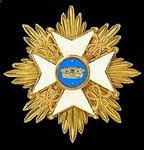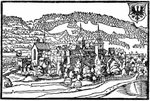First raised 17th February 1672 by Pierre Stuppa. A Swiss regiment, one of four permanent Swiss regiments in the French army after the Swiss Guards; Stuppa was a captain in the Swiss Guards and given the task by the king, Louis XIV, of raising the units. Originally 12 companies each of 200 men. Regiment Stuppa was raised in the cantons of Solothurn, Aargau, Fribourg and Grisons/Graubünden. Became Brendlé in 1701, Séedorf in 1738, Boccard in 1752 and Salis-Samade in 1782.
These flags were carried at least 1701-1738 but probably earlier too.

Service to the end of the War of the Spanish Succession (mostly from Susane):
1672 Army of the Netherlands: Siege of Doesbourg; combat of Woerden; taking of Utrecht (where it was left as garrison to 7th November 1673).
1674 Expedition of the Duc de Luxembourg to Holland; destruction of Bodegrave and Swammerdam.
1674 Battle of Seneffe; Captain Burckart and other officers were killed in the attack on the village of Fay.
1675 Capture of Liège; helped cover the sieges of Dinant, Huy and Limburg.
1676 Sieges of Landrecies and Condé; helped cover the sieges of Bouchain, St Ghislain and Aire.
1677 Now called Stuppa Vieux to distinguish it from another Swiss regiment of the same name raised 1677, the regiment served at the siege of Cambrai and its citadel. Part of the Corps of the Duc d'Orléans before St Omer; fought bravely at Cassel where six officers were wounded. Capture of St Omer and St Ghislain.
1678 Sieges of Gand and Ypres; 11th August in the combat at St Denis where seven officers were wounded.
1684 Siege of Luxembourg.
1689 1st battalion at the battle of Walcourt.
1690 The whole regiment was at the battle of Fleurus where four officers were wounded.
1691 March - Siege of Mons.
1692 Siege of Namur; after the capture of the town and during the attack on the citadel, especially Fort Guillaume, there was a sortie on the night of 17th-18th June. In repelling the sortie Lieutenant-Colonel Frey of the regiment was killed, as was Major Sprecher during the final assault, which was carried with such fury that the king gave a louis d'or to each grenadier.
1692 Battle of Steenkerque; Stuppa was in the second line behind Regiment Bourbonnais. During the battle the regiment fought the Danish Guards, sustaining a tremendous firefight for an hour without either side giving way. Eventually, supported by the Swiss Guards, Stuppa pushed the Danes back and defeated them. Of the four battalions of Stuppa, only three captains survived unwounded from this furious attack. Lieutenant-Colonel Russinger, Major Courten, captains Zurlauben, Burckart, Socin, La Hire Sülzer, Tellung and two lieutenants were killed. Colonel Stuppa and nineteen other officers were wounded; 613 sergeants and soldiers were wounded, 242 mortally. After this the remnants of the regiment went into garrison at Lille, from where during the feast of Christmas they sortied to take Furnes.
1693 Conquest of Hui; battle of Neerwinden brigaded with Regiment Surbeck where it performed prodigies and suffered heavy casualties including Captain Petitot; siege of Charleroi where the 4th battalion stayed after its conquest.
1695 Defence of the fort and canal of La Knocque where ensign Sock was killed; July siege of Dixmude; August bombardment of Brussels.
1696 Flanders; then coast of Picardy. While passing through Arras, the regiment was the victim of a terrible accident. The 3rd and 4th battalions had been lodged in the Hôtel de Ville. The floor of the 2nd floor gave way under the weight of the 4th battalion, which collapsed onto the 3rd battalion. There were 150 men killed or wounded.
1697 Flanders; capture of Ath. At the peace sent as garrison to Lille.
1698 Camp of Compiègne; to Douai where reduced to three battalions.
1701 Became Brendlé
1702 Cannonade of Peer and siege of Trarbach; in garrison at Bruges
1703-1704 Pikes were given up. Pikemen, who had previously worn Swiss national costume, were armed with muskets and dressed in the same red uniform as the other soldiers in the regiment.
1705 Siege of Huy
1706 Relief of Fort-Louis on the Rhine; back to Flanders where the 1st and 3rd battalions were sent to Mons and the 2nd to Ath. 200 men were sent from Mons to guard Termonde. These 200 plus the battalion at Ath were soon captured by the Allies but a large number escaped and the 2nd battalion was reorganised at Landrecies. Captain Iseling and lieutenant Husy were killed in the defence of Ath.
1707 The regiment was sent to Toulon which was besieged by the Imperialists. The siege was lifted and the enemy recrossed the Var.
1708 Return to Flanders; battle of Oudenarde, where it was little engaged.
1709 Fought valiantly at the battle of Malplaquet where it supported the efforts of the Piémont brigade and also the retreat of the Maison du Roi. During the retreat Brendlé formed the extreme rear guard of the whole army.Captain Geschwind was killed.
1710 Heavily involved in the defence of Douai to its surrender.
1711 The regiment was distinguished in the storming of the fort of Arleux then garrisoned Valenciennes, threatened by the enemy.
1712 Contributed to the success of the enterprise of Denain, and took part in the sieges of Marchiennes, Douai and Du Quesnoy
1713 Siege of Landau; on 2nd July helped Regiment Navarre to repel a sortie which put the siege in peril. Captain Wickhart and lieutenants Horner and Ze-Rhym were killed. During the siege of Freiburg the regiment was on the left bank of the Rhine in the Lines of the Lauter and at the peace put into garrison at Metz.
The uniform, according to Hall, seems to have fluctuated between red with blue facings and blue with red facings throughout the period discussed here!
And here are the flags in action with Simon Miller's troops (picture by Simon Miller):





















































